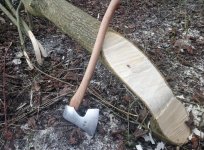G
Gimlet
Guest
Wild birds love hedges for the same reason.Oh my goodness go on!
I never thought about British hedgerows, instead we Yanks get told about how the Germans were so tough to displace from the hedgerows of Normandy.
Wild birds love hedges for the same reason.Oh my goodness go on!
I never thought about British hedgerows, instead we Yanks get told about how the Germans were so tough to displace from the hedgerows of Normandy.
Are you kidding!!!?? No way, that is fascinating work and skill set. We have nothing like this here in the US. I encounter very old,field stone fencing, but now that is largely decorative and not entrusted for livestock containment (for the most part).Apologies if I'm derailing the thread by the way.
Here's another one. Hazel, about 18 feet high at the start and a full-sized cow could have sauntered straight through it.Oh my goodness go on!
I never thought about British hedgerows, instead we Yanks get told about how the Germans were so tough to displace from the hedgerows of Normandy.



You could have laid hedging. Most deciduous species will take it, though some have more cooperative growth habits than others.Are you kidding!!!?? No way, that is fascinating work and skill set. We have nothing like this here in the US. I encounter very old,field stone fencing, but now that is largely decorative and not entrusted for livestock containment (for the most part).
Here's another one. Hazel, about 18 feet high at the start and a full-sized cow could have sauntered straight through it.
View attachment 257155
And after treatment:
View attachment 257157
My usual avatar on social media. A John Beavis made 3 1/2 Lb hedging axe that's just dealt with a walnut tree:
View attachment 257158
First question: you start at one end, usually the highest ground level and work your way back downhill one stem at a time. Each stem is pleach cut, meaning it's cut about 3/4s of the way through at ground level to create a "tongue" or flexible hinge. Each stem is then bent downwards from the hinge and simply woven by hand into those laid previously. The weaving is to keep them in place and create an impenetrable barrier to livestock. there's no particular pattern to it. If you work in sympathy with the plant each stem will more or less tell you where it needs to go. You're not forcing or coercing anything, just feeling what it wants to do and working with it.Two questions please?
How do you get the tall trees to twine together?
I’ve heard of the legend of Blackjack hand hammer forged axes that cost sixty dollars back when a $20 gold piece was one Troy ounce of gold.
The fish gigs I did see, supposedly cost $20 in the twenties which would be a fabulous price in our money today.
They were branded by the maker, and highly prized. Not like this one.
View attachment 257159
How is a hand forged blacksmith made axe made to make it worth so much?
Nothing wrong with that. Perfectly good looking bit if dry stone walling. Wouldn't look out of place in the English Pennines.Here is a Maryland example. These folks do keep sheep in here. Excuse my gravel bike!
View attachment 257187
I'm wearing the engine, both of them!Nothing wrong with that. Perfectly good looking bit if dry stone walling. Wouldn't look out of place in the English Pennines.
There's something wrong with your bike though. The engine appears to have fallen out.
Fifty years ago was actually modern times as far as power tools go. The basic gadget hadn’t changed in a hundred years and really is the same today.lf people use tools on a more or less daily basis, they need higher quality. For the average householder like me, a big tool box may hold all you need.
Sears used to have Craftsmen tools, now sold by Ace Hardware I believe. It used to be that if the tool wore out in standard usage, you could send it in and get a free replacement.
Briar, I have that same Black and Decker corded drill. We've had many adventures together.
As I’ve said many times, before and even after my father died when I was thirteen and all we had was Mama’s $500 a month schoolteacher’s check and the farm rent, I never knew a really desperate minute about paying for the things we needed.My dear solicitor, you get spoiled by every cheap Chinese products. Somebody's gotta send them to colleges in US.
The better gambit is to charm the prosecutors.Briar Lee, I write this in all good humor but, I bet befuddling judges in your forte.
Unfortunately, I think the steel age never outlasts, in regards artifact permanence, the stone age. That's why our infrastructure is collapsing.I’m sitting here ruminating what will ever become of the millions upon countless millions of extra tools we buy in another fifty years, and fifty more years after that.
No homeowner ever throws away or wears out or breaks a pair of water pump pliers.
They’ll be like flint arrowheads, in a couple of thousand years, I suppose.
Tools are so cheap we take them for granted.
I love to look up facts:Unfortunately, I think the steel age never outlasts, in regards artifact permanence, the stone age. That's why our infrastructure is collapsing.
Yup, some drystone walls here in Britain date back to the bronze age. Here in West Cornwall they are in abundance, also on Bodmin Moor & Dartmoor in Devon.Wouldn't look out of place in the English Pennines.


